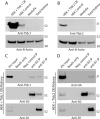The evolutionary conserved TLDc domain defines a new class of (H+)V-ATPase interacting proteins
- PMID: 34811399
- PMCID: PMC8608904
- DOI: 10.1038/s41598-021-01809-y
The evolutionary conserved TLDc domain defines a new class of (H+)V-ATPase interacting proteins
Erratum in
-
Author Correction: The evolutionary conserved TLDc domain defines a new class of (H+)V-ATPase interacting proteins.Sci Rep. 2021 Nov 30;11(1):23481. doi: 10.1038/s41598-021-02955-z. Sci Rep. 2021. PMID: 34848813 Free PMC article. No abstract available.
Abstract
We recently found that nuclear receptor coactivator 7 (Ncoa7) and Oxr1 interact with the proton-pumping V-ATPase. Ncoa7 and Oxr1 belong to a group of proteins playing a role in the oxidative stress response, that contain the conserved "TLDc" domain. Here we asked if the three other proteins in this family, i.e., Tbc1d24, Tldc1 and Tldc2 also interact with the V-ATPase and if the TLDc domains are involved in all these interactions. By co-immunoprecipitation, endogenous kidney Tbc1d24 (and Ncoa7 and Oxr1) and overexpressed Tldc1 and Tldc2, all interacted with the V-ATPase. In addition, purified TLDc domains of Ncoa7, Oxr1 and Tldc2 (but not Tbc1d24 or Tldc1) interacted with V-ATPase in GST pull-downs. At the amino acid level, point mutations G815A, G845A and G896A in conserved regions of the Ncoa7 TLDc domain abolished interaction with the V-ATPase, and S817A, L926A and E938A mutations resulted in decreased interaction. Furthermore, poly-E motifs upstream of the TLDc domain in Ncoa7 and Tldc2 show a (nonsignificant) trend towards enhancing the interaction with V-ATPase. Our principal finding is that all five members of the TLDc family of proteins interact with the V-ATPase. We conclude that the TLDc motif defines a new class of V-ATPase interacting regulatory proteins.
© 2021. The Author(s).
Conflict of interest statement
The authors declare no competing interests.
Figures






Similar articles
-
Oxr1 and Ncoa7 regulate V-ATPase to achieve optimal pH for glycosylation within the Golgi apparatus and trans-Golgi network.Proc Natl Acad Sci U S A. 2025 Jun 3;122(22):e2505975122. doi: 10.1073/pnas.2505975122. Epub 2025 May 30. Proc Natl Acad Sci U S A. 2025. PMID: 40445757 Free PMC article.
-
Human V-ATPase function is positively and negatively regulated by TLDc proteins.Structure. 2024 Jul 11;32(7):989-1000.e6. doi: 10.1016/j.str.2024.03.009. Epub 2024 Apr 8. Structure. 2024. PMID: 38593795 Free PMC article.
-
Crystal structure of the TLDc domain of human NCOA7-AS.Acta Crystallogr F Struct Biol Commun. 2021 Aug 1;77(Pt 8):230-237. doi: 10.1107/S2053230X21006853. Epub 2021 Jul 28. Acta Crystallogr F Struct Biol Commun. 2021. PMID: 34341188 Free PMC article.
-
TLDc proteins: new players in the oxidative stress response and neurological disease.Mamm Genome. 2017 Oct;28(9-10):395-406. doi: 10.1007/s00335-017-9706-7. Epub 2017 Jul 13. Mamm Genome. 2017. PMID: 28707022 Free PMC article. Review.
-
The emerging roles of vacuolar-type ATPase-dependent Lysosomal acidification in neurodegenerative diseases.Transl Neurodegener. 2020 May 11;9(1):17. doi: 10.1186/s40035-020-00196-0. Transl Neurodegener. 2020. PMID: 32393395 Free PMC article. Review.
Cited by
-
Oxr1 and Ncoa7 regulate V-ATPase to achieve optimal pH for glycosylation within the Golgi apparatus and trans-Golgi network.Proc Natl Acad Sci U S A. 2025 Jun 3;122(22):e2505975122. doi: 10.1073/pnas.2505975122. Epub 2025 May 30. Proc Natl Acad Sci U S A. 2025. PMID: 40445757 Free PMC article.
-
Knockout of the V-ATPase interacting protein Tldc2 in B-type kidney intercalated cells impairs urine alkalinization.Am J Physiol Renal Physiol. 2025 Jun 1;328(6):F890-F906. doi: 10.1152/ajprenal.00363.2024. Epub 2025 May 13. Am J Physiol Renal Physiol. 2025. PMID: 40358928 Free PMC article.
-
Lysosomal dysfunction and inflammatory sterol metabolism in pulmonary arterial hypertension.Science. 2025 Jan 24;387(6732):eadn7277. doi: 10.1126/science.adn7277. Epub 2025 Jan 24. Science. 2025. PMID: 39847635 Free PMC article.
-
Interaction between the TBC1D24 TLDc domain and the KIBRA C2 domain is disrupted by two epilepsy-associated TBC1D24 missense variants.J Biol Chem. 2024 Sep;300(9):107725. doi: 10.1016/j.jbc.2024.107725. Epub 2024 Aug 28. J Biol Chem. 2024. PMID: 39214300 Free PMC article.
-
CryoEM of endogenous mammalian V-ATPase interacting with the TLDc protein mEAK-7.Life Sci Alliance. 2022 Jul 6;5(11):e202201527. doi: 10.26508/lsa.202201527. Print 2022 Nov. Life Sci Alliance. 2022. PMID: 35794005 Free PMC article.
References
Publication types
MeSH terms
Substances
Grants and funding
LinkOut - more resources
Full Text Sources
Molecular Biology Databases
Research Materials

